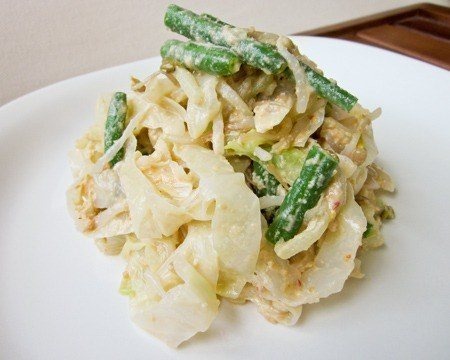Gado Gado (Indonesian Cooked Vegetable Salad With Peanut Dressing)
Gado Gado (Indonesian Cooked Vegetable Salad With Peanut Dressing)
"Gado" in Bahasa Indonesia usually means one of two things: 1) to eat something raw or 2) to eat something without rice. So important is rice in the typical Indonesian meal that one word has been set aside to designate the unusual practice of eating something without the staple crop.
Since most of the vegetables in this salad are cooked, and as far as I can recall, I have never seen someone enjoy this dish with rice, it's probably safe to go with the second definition in this context.
Saying something descriptive twice, though, is a way of denoting emphasis, as in, "really really." And so, in reading "gado gado," or "gado²" the translation could be roughly interpreted as "you really, really shouldn't eat this with rice." Why? Because it would be weird.
This is a light and refreshing salad popular in many parts of Indonesia. I suspect it is of Javanese origin because of its notably sweet flavor profile and use of (ideally) Javanese palm sugar. No palm sugar? No problem — dark brown sugar makes a decent substitute. Same thing with the "kangkung" — it's a green leafy Chinese vegetable for which spinach is a good substitute; for those of you familiar with Malaysian cuisine, it's the vegetable that's in kangkung belacan. And if the shrimp paste has you worried, no sweat — it's not completely necessary. The most important thing to remember about this salad is that when you serve it, eat it right off the bat. Don’t let it sit, because the vegetables have a lot of water that thins out the dressing (a good thing, at first, since it's pretty thick), but after awhile... not so good.
Anyway, the next time it's 100 degrees out at 100-percent humidity and hazy (normal weather in the capital, Jakarta), give this recipe a whirl.
Many thanks to Zulinda Budiaman, my mother, for helping me with this recipe.
Click here to see more peanut recipes.
Click here to see Beyond Sriracha: Sambal Oelek.
Servings
6

Ingredients
- one-quarter 3 ½-pound cabbage, cored and sliced thinly
- 2 cup chopped green beans or chinese long beans (1-inch lengths)
- 1 pound bean sprouts
- 1 mirliton (chayote squash), peeled, cored and julienned
- 2 cup spinach or chinese kangkung (optional)
- 1 cup unsalted dry-roasted peanuts
- 2 tablespoon dark brown or palm sugar
- 1/2 cup water
- 2 teaspoon sambal oelek or 1 red chile pepper, seeded and chopped
- 1 teaspoon fermented shrimp paste (optional)*
- 1 cucumber, peeled and sliced into half-discs (optional)
Directions
- Bring 4 quarts water to a boil in a large pot over high heat. Prepare an ice bath in a large bowl. Blanch the vegetables for these listed times, immediately plunging each vegetable into the ice bath afterward and then draining: cabbage, until crisp tender, about 7 minutes; green beans, until crisp tender, about 2 minutes; bean sprouts, until cooked through, about 10 minutes; mirliton, until soft, about 3 minutes; spinach, if using, until just wilted, about 30 seconds.
- Meanwhile, prepare the dressing. Combine the peanuts and sugar in the bowl of a food processor and pulse until combined. With the machine running, gradually add the water until slightly grainy while still runny. It should not turn creamy like peanut butter; there should still be some texture.** Blend in the sambal oelek or chile pepper and fermented shrimp paste, if using.
- Once the vegetables are done, chill the vegetables in the refrigerator first, if desired. Bunch the cabbage up and squeeze out as much moisture as possible. Then, combine it in a large bowl with the other vegetables and cucumber, if using, and gently toss by hand together with the dressing. Serve immediately.